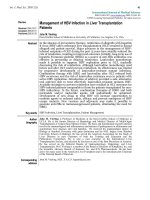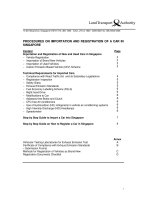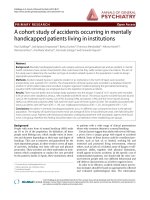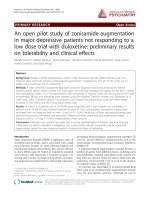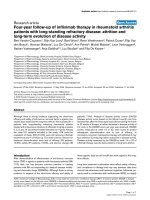GENETICS OF NEPHROTIC SYNDROME IN SINGAPORE PAEDIATRICS PATIENTS
Bạn đang xem bản rút gọn của tài liệu. Xem và tải ngay bản đầy đủ của tài liệu tại đây (1.44 MB, 160 trang )
GENETICS OF NEPHROTIC SYNDROME IN
SINGAPORE PAEDIATRICS PATIENTS
NG JUN LI
(BSC), NUS
A THESIS SUBMITTED FOR THE
DEGREE OF MASTERS OF SCIENCE
DEPARTMENT OF PAEDIATRICS
NATIONAL UNIVERSITY OF SINGAPORE
2012
Acknowledgements
I would like to express my thankfulness to:
My supervisor, Professor Yap Hui Kim, for her guidance throughout these years.
My co‐supervisor, Associate Professor Heng Chew Kiat, for his statistical advices.
Dr Ng Kar Hui, for her continuous help and support.
Dr Isaac Liu and Dr U Mya Than, for their help in collecting the clinical data of the
patients.
Dr Leow Koon Yeow, for his technical advices on the use of high resolution melting for
screening.
Chan Chang Yien, Joni, Chong, Liang Ai Wei, Lauretta Low, Sun Zijin, Seah Ching Ching
and Toh Xue Yun, for their company and help that they provided.
My family for their continuous support and encouragement.
This work was supported by grants NKFRC/2007/09 from National Kidney Foundation
and NMRC IRG07 May 104 from the National Medical Research Council, Singapore.
i
Table of contents
1.
Introduction ................................................................................................................ 1
1.1. Nephrotic syndrome ............................................................................................ 1
1.1.1.
Epidemiology and histological features of childhood NS ............................. 1
1.1.2.
Clinical course of childhood NS ..................................................................... 3
1.1.3.
Pathogenesis of nephrotic syndrome ........................................................... 7
1.2. Podocytes: Their role in nephrotic syndrome .................................................... 11
1.2.1.
The slit diaphragm ...................................................................................... 12
1.2.2.
Cytoskeletal proteins .................................................................................. 18
1.2.3.
Cell matrix adhesion complexes ................................................................. 19
1.2.4.
Podocytes and Nephrotic syndrome .......................................................... 20
1.3. Genetics of nephrotic syndrome ........................................................................ 22
1.3.1.
NPHS1: The gene encoding for nephrin ...................................................... 28
1.3.2.
NPHS2: The gene encoding for podocin ..................................................... 32
1.3.3.
The two closely related partners: NPHS1 and NPHS2 ................................ 39
1.4. Gaps in current knowledge ................................................................................ 43
1.5. Objectives of the study ...................................................................................... 44
2.
Methods and Materials ............................................................................................. 46
2.1. Study Subjects .................................................................................................... 46
ii
2.2. Data collection.................................................................................................... 47
2.3. Genomic DNA (gDNA) extraction ....................................................................... 48
2.4. Primer design and melting domain analysis ...................................................... 48
2.5. PCR amplification ............................................................................................... 53
2.6. High Resolution Melting ..................................................................................... 54
2.7. Direct Sequencing .............................................................................................. 55
2.8. Genotyping by tetra‐primers ARMS PCR ............................................................ 56
2.9. Genotyping by RFLP ........................................................................................... 60
3.
2.10.
Statistical analysis ........................................................................................... 62
2.11.
Prediction of the effect of the genetic variants ............................................. 63
2.12.
Protein sequence alignment ........................................................................... 64
Results ....................................................................................................................... 66
3.1. Clinical Characteristics ........................................................................................ 66
3.2. Genetic variants in NPHS1 .................................................................................. 69
3.2.1.
Screening for variants in NPHS1 using HRM ............................................... 69
3.2.2.
Statistical analysis of the genetic variants in NPHS1 .................................. 74
3.2.3.
Prediction of the effect of the genetic variants .......................................... 81
3.3. Genetic variants in NPHS2 .................................................................................. 85
3.3.1.
Screening of NPHS2 using direct sequencing ............................................. 85
iii
3.3.2.
Statistical analysis of the genetic variants in NPHS2 .................................. 87
3.3.3.
Prediction of the effect of the genetic variants .......................................... 91
3.4. Phenotype‐genotype associations ..................................................................... 93
3.5. Analysis of composite genotypes of genetic variants in NPHS1 and NPHS2 ..... 97
3.6. Contribution of rare alleles to nephrotic syndrome ........................................ 101
4.
Discussion................................................................................................................ 112
4.1. Polymorphisms and their association with nephrotic syndrome .................... 114
4.2. Phenotype‐genotype correlations of the genetic variants .............................. 118
4.3. Gene‐gene interaction of NPHS1 and NPHS2 .................................................. 120
4.4. Contribution of rare variants to nephrotic syndrome ..................................... 122
5.
Conclusion ............................................................................................................... 127
6.
Reference ................................................................................................................ 128
iv
Summary
Background
Nephrotic syndrome (NS) is the most common glomerulonephritis in childhood, 20% of
which are steroid‐resistant. Mutations in podocyte‐related genes have been shown to
cause idiopathic NS in Caucasian populations, whereas Asian studies are lacking. The
aims of this study are firstly to identify genetic variants in nephrin(NPHS1) and
podocin(NPHS2), two important podocyte‐associated genes, in paediatric patients with
idiopathic NS in Singapore, secondly to determine the presence of disease associations
with these genetic variants, and lastly to investigate if there are any gene‐gene
interactions.
Methods
Genetic screening of NPHS1 and NPHS2 was performed on 121 patients (97Chinese,
24Malays) with disease onset at a mean age of 5.69±4.43 years. High Resolution Melting
was used to detect genetic variants in NPHS1, and these were validated by bi‐directional
sequencing. Direct sequencing was used to detect genetic variants in NPHS2. All genetic
variants identified were genotyped in cord blood controls (125Chinese; 96Malays) by
Restriction Fragment Length Polymorphism, Tetra‐primer Amplification Refractory
Mutation System PCR and sequencing. Data from the Singapore Genome Variation
Project involving healthy individuals (96Chinese; 89Malays) and SNP arrays from the
Genome Institute of Singapore involving 1682 Chinese controls were used for our
analysis. Statistical analysis was performed using SNPstats and SPSS v17. Multiple
v
logistic regression analysis (codominant, dominant, recessive and log‐additive models)
was done to determine the significance of genetic variants and phenotype associations.
Computer prediction programs were used to predict the functional effects of these
genetic variants.
Results
Sixteen genetic variants in NPHS1 were found in our cohort of nephrotic patients, of
which 5 was novel. c.294C>T, and c.2289C>T were significantly associated with NS in
both Chinese and Malay patients, whereas c.349G>A was significantly associated with
NS in only Chinese patients. c.349G>A resulted in an amino acid substitution of glutamic
acid to lysine at position 117. c.294C>T, c.349G>A and c.2289C>T have been found to
affect the ESE and/or ESS sites.
We found 8 genetic variants in NPHS2, of which 1 was novel. In our Chinese patients, c.‐
51G>T was significantly associated with NS. c.288C>T was observed to have a protective
effect against NS, whereas c.‐51G>T and c.1038A.G were associated with steroid
resistance. c.1038A>G was also associated with cyclosporine resistance.
Binary logistic regression showed that the composite genotypes of GG/CC/CT and
GT/CC/CT for NPHS2 c.‐51G>T and c.288C>T and NPHS1 c.2289C>T were significantly
associated with NS. The composite genotypes of GG/CC/TT and GT/CC/CC were also
associated with steroid resistance.
vi
Additionally, we have shown a significant accumulation of rare variants in nephrotic
patients compared to controls, and also in nephrotic patients with poor prognosis
compared to those who responded well to therapy.
Conclusion
Genetic variants in podocyte‐related genes were present in paediatric patients with
idiopathic NS in Singapore, and they occurred at frequencies which differed from
Caucasian populations. Phenotype association studies implicated NPHS2 polymorphisms
with steroid and cyclosporine resistance, whereas rare variants accumulation was
associated with poor prognosis. Additionally, gene‐gene interactions between NPHS1
and NPHS2 were observed in our nephrotic population. Functional studies are required
to better understand the mechanisms of the genetic variants in the pathogenesis of NS.
vii
List of Tables
Table 1: Summary of genetic involvement in pathogenesis of nephrotic syndrome. ...... 24
Table 2: NPHS1 and NPHS2 genetic variants identified in familial and sporadic nephrotic
syndrome. ................................................................................................................. 25
Table 3: Primers used for the screening of NPHS1 using HRM. ....................................... 50
Table 4: Primers used for the screening of NPHS2 using direct sequencing. ................... 52
Table 5: Primers used in tetra‐ARMS PCR for the genotyping of NPHS1 SNPs. ............... 58
Table 6: Restriction enzymes used for the genotyping of NPHS1 SNPs. .......................... 61
Table 7: General characteristics of Chinese and Malay patients with idiopathic sporadic
nephrotic syndrome and/or FSGS. ............................................................................ 68
Table 8: Genetic variants identified in NPHS1 using HRM. ............................................... 70
Table 9: Allele frequencies of NPHS1 SNPs in Chinese (n=97). ......................................... 77
Table 10: Genotype frequency for NPHS1 SNPs in Chinese (n=97). ................................. 77
Table 11: Association analysis of NPHS1 genotypes with nephrotic syndrome in Chinese.
................................................................................................................................... 78
Table 12:Allele frequencies of NPHS1 SNPs in Malay (n=24). .......................................... 79
Table 13: Genotype frequencies of NPHS1 SNPs in Malay (n=24). .................................. 79
Table 14: Association analysis of NPHS1 genotypes with nephrotic syndrome in Malay
(n=24). ....................................................................................................................... 80
Table 15: Prediction of the effect of amino acid substitution of the various genetic
variants on the protein using SIFT and PolyPhen2. .................................................. 82
Table 16: Effect of the individual NPHS1 SNPs on ESE/ESS sites. ..................................... 84
Table 17: Genetic variants identified in NPHS2 using direct sequencing. ........................ 85
viii
Table 18: Allele frequencies of NPHS2 variants in Chinese (n=97). .................................. 89
Table 19: Genotype frequencies of NPHS2 variants in Chinese (n=97). ........................... 89
Table 20: Association analysis of c.‐51G>T and c.288C>T in Chinese patients (n=97). .... 90
Table 21: Effect of the individual NPHS2 SNPs on ESE/ESS sites. ..................................... 92
Table 22: Genotype‐phenotype association in Chinese patients for NPHS2. .................. 95
Table 23: Allele frequencies for NPHS2 SNPs with phenotype‐genotype associations in
Chinese patients. ....................................................................................................... 96
Table 24: Composite genotype analysis of patients, with race as co‐variant. ................. 98
Table 25: Composite genotype analysis for SRNS patients, with race as co‐variant...... 100
Table 26: Rare NPHS1 and NPHS2 variants identified in NS patients and their minor allele
frequencies in patients and controls. ..................................................................... 102
Table 27: Non‐synonymous NPHS1 and NPHS2 rare variants identified in nephrotic
syndrome patients and their predicted effects ...................................................... 103
Table 28: Rare variants accumulation in nephrotic syndrome patients and controls ... 104
Table 29: Accumulation of rare variants in patients with poor prognosis. .................... 106
Table 30: Clinical characteristics of patients with rare variants. .................................... 107
ix
List of Figures
Figure 1: Histology of the glomerulus in (A) MCNS and (B) FSGS (Periodic acid‐Shiff stain).
..................................................................................................................................... 2
Figure 2: MCNS and FSGS are the most common histological patterns seen in steroid‐
resistant nephrotic syndrome. .................................................................................... 5
Figure 3: The glomerular filtration barrier. ......................................................................... 9
Figure 4: Distribution of the histological profile in the nephrotic patients. ..................... 69
Figure 5: Normalized high resolution melting curves and the corresponding difference
plots. .......................................................................................................................... 71
Figure 6: Electrophoretograms of the various genetic variants. ...................................... 72
Figure 7: Genotyping results of c.2289C>T and c.3315A>G. ............................................ 73
Figure 8: Electrophoretograms of the various genetic variants. ...................................... 86
Figure 9: Pedigree of Patient 94. .................................................................................... 111
x
List of Abbreviations
ACTN4
Alpha actinin 4
AIC
Akaike Information
ARMS
Amplification refractory mutation system
CD2AP
CD2‐associated proteins
CNF
Congenital nephrotic syndrome of the Finnish type
CNI
Calcineurin inhibitors
CNS
Congenital nephrotic syndrome
CsA
Cyclosporine
DAG
Diacylglycerol
DMS
Diffuse mesangial sclerosis
EDTA
Ethylenediaminetetraacetic
ESE
Exon splicing enhancer
ESRD
End stage renal disease
ESS
Exon splicing silencer
FGS
Focal global sclerosis
FMPGN
Focal mesangial proliferative glomerulonephritis
FSGS
Focal segmental glomerulosclerosis
GBM
Glomerular basement membrane
gDNA
Genomic DNA
HRM
High resolution melting
IP3
Inositol 1,4,5‐triphosphate
xi
IQGAP‐1
IQ motif–containing GTPase‐activating protein 1
ISKDC
International Study of Kidney Diseases in Children
MCNS
Minimal change nephrotic syndrome
MPGN
Membranoproliferative glomerulonephritis
NS
Nephrotic syndrome
NUH
National University Hospital of Singapore
PCR
Polymerase chain reaction
PFS
Potentially Functional SNP
PI3K
Phosphoinositide 3‐OH kinase
RFLP
Restriction fragment length polymorphism
Rs number
RefSNP accession ID
SD
Slit diaphragm
SDNS
Steroid dependent nephrotic syndrome
SGVP
Singapore Genome Variation Project
SIFT
Sorting intolerant from tolerant
SNP
Single nucleotide polymorphism
SRNS
Steroid resistant nephrotic syndrome
SSNS
Steroid sensitive nephrotic syndrome
suPAR
Serum soluble urokinase receptor
TRP
Transient receptor potential
USF
Upstream stimulatory factor
xii
List of Appendices
Appendix I: Clinical characteristics and genotype profile of the patients……………………146
Appendix II: Hardy‐Weinberg Results for NPHS1 and NPHS2 variants………………………..158
Appendix III: Linkage disequilibrium results for NPHS1 and NPHS2 variants……………….163
Appendix IV: Protein sequence alignment for nephrin and podocin…………………………..167
xiii
List of conference abstracts and awards
6th Congress of Asian Society for Paediatrics Research, Taipei, 2010
Title: Comparison of NPHS2 polymorphisms and their associations with end‐stage renal
disease in Chinese and Malay children.
Award: Best Poster Award
11th Asian Congress of Paediatrics Nephrology, Fukuoka, 2011
Title: Nephrin gene variants may account for ethnic differences in susceptibility to
sporadic Nephrotic Syndrome in Singapore children.
Award: Travel grant
8th Congress of Asian Society for Paediatrics Research, Seoul, 2012
Title: Multiple Rare Alleles in Nephrin and Podocin Contribute to Poor Prognosis in
Childhood Nephrotic Syndrome in Singapore.
Nominated for Young Investigator Award
xiv
1. Introduction
1.1. Nephrotic syndrome
Nephrotic syndrome (NS) is a common cause of kidney disease in children. It is
characterized by heavy proteinuria, hypoalbuminaemia, oedema and hyperlipidaemia
(Yu et al., 2005). There have been various definitions used to describe nephrotic‐range
proteinuria, including urinary protein excretion ≥3 g/day/1.73m2 or a spot urinary
protein:creatinine ratio ≥0.2 g/mmol (Yap and Lau, 2008).
NS in children can be congenital, which is presented at birth or during first 3 months of
life, or presented in later part of their life. Childhood NS is due to either primary or
secondary causes. Some examples of primary causes are genetic disorders or defects in
the glomerular filtration barrier. Infections, drug usage and immunological or allergic
disorders are some of the secondary causes of childhood NS (Eddy and Symons, 2003).
In this literature review, the main focus would be primary NS in children.
1.1.1. Epidemiology and histological features of childhood NS
The reported incidence of idiopathic NS is 2 to 7 cases per 100 000 children. It has a
prevalence of approximately 16 cases per 100 000 (Eddy and Symons, 2003). The two
distinct histological features of primary idiopathic NS in children are minimal change
nephrotic syndrome (MCNS), and focal segmental glomerulosclerosis (FSGS) (Figure 1).
1
Fiigure 1: Histtology of the
e glomerulus in (A) MCN
NS and (B) FFSGS (Period
dic acid‐Shifff
sttain).
MCNS,
M
which
h is characte
erized by minor
m
morphhological alteration in p
podocytes, is the
most
m
commo
on pathologiical type in childhood nnephrotic syyndrome. (Zhu et al., 2
2009,
Laahdenkari et al., 2005). On light microscopy,
m
tthe glomeru
ulus for MCN
NS looks no
ormal,
whereas
w
elecctron microscopy show
ws the preseence of efffacement off the glomeerular
epithelial foo
ot processes during relap
pses of the ddisease (Kum
mar et al., 20
003)
FSSGS is characterized byy a commo
on pattern oof glomerulaar injury that is defineed by
se
egmental sclerotic lesions invading a populatioon of glomerruli (Tsukagu
uchi et al., 2
2002).
This is often associated with tubulaar scarring aand interstittial fibrosis. Five varian
nts of
FSSGS have been defined
d according to their paathology: co
ollapsing, ceellular, tip leesion,
perihilar and not‐otherw
wise‐specified
d (Thomas eet al., 2006)). FSGS is also an impo
ortant
mary nephrottic syndrome in adults. FFSGS carriess a poor proggnosis with more
caause of prim
th
han 25% of cchildren and
d adults proggressing to eend stage reenal diseasee (ESRD) in w
within
five years of onset of NSS (McKenzie et al., 20077). It has beeen observed
d that there is an
2
increased incidence of FSGS in both children and adults, especially in black individuals in
the United States (Eddy and Symons, 2003, Mollet et al., 2009).
1.1.2. Clinical course of childhood NS
Steroids are the mainstay of therapy for children with NS. The initial steroid treatment is
prednisone 60 mg/m2 per day for 4 weeks, with the maximum dosage to be 80mg. This
is followed by prednisone 40 mg/m2 on alternate days for 4 weeks, with a steroid taper
over 3 to 6 months (Eddy and Symons, 2003). Steroid sensitive nephrotic syndrome
(SSNS) is defined as patients being able to enter remission in response to corticosteroid
treatment alone. Steroid resistant nephrotic syndrome (SRNS) is the inability to induce
remission after 8 weeks of corticosteroid treatment. Steroid dependent nephrotic
syndrome (SDNS) is the initial response to corticosteroid treatment by entering
complete remission but the development of relapse either while still receiving steroids
or within 2 weeks of discontinuation of treatment following a steroid taper. Patients
with SDNS require the continued low‐dose treatment with steroids to prevent
development of relapse (Gbadegesin and Smoyer, 2008).
A multicenter International Study of Kidney Diseases in Children (ISKDC) study was
performed on more than 521 children with idiopathic NS in the late 70s and early 80s.
The study revealed that approximately 80% of children with idiopathic NS respond to
steroid therapy. Steroid responsiveness was observed in 93% of the children with MCNS,
compared to only 30% of children with FSGS (Gbadegesin and Smoyer, 2008).
3
Twenty percent of children with NS are resistant to steroid therapy. They fail to respond
to corticosteroids (Schwaderer et al., 2008). According to the study by ISKDC, for the
103 children who were steroid‐resistant, MCNS, FSGS and membranoproliferative
glomerulonephritis (MPGN) were the most prevalent lesions present, each accounting
for approximately 25% of the histological findings (ISKDC, 1981) (Figure 2). In Singapore,
renal biopsies of 47 children with SRNS showed that MCNS (30%) and FSGS (49%) were
the two main causes of SRNS (Yap, 2005) (Figure 2). The prognosis for children with
SRNS is often poor. They usually rapidly progress to end stage renal disease within 10
years from diagnosis (Kitamura et al., 2006, Schultheiss et al., 2004). These children are
also more prone to more complicated clinical and therapeutic course, which will result
in ESRD in 30 to 40% (Schwaderer et al., 2008) .
4
Fiigure 2: MC
CNS and FSG
GS are the m
most commo
on histologiccal patternss seen in steeroid‐
re
esistant nep
phrotic syndrome.
CGN: Chronicc glomerulonephritis. DMH:
D
Diffusee mesangial hypercellullarity. FGS: Focal
global glome
erulosclerosis. FSGS: Focal segmenttal glomeru
ulonephritis. MCNS: Min
nimal
ch
hange neph
hrotic syndrrome. Mem
mbGN: Mem
mbranous glomerulonep
phritis. MessPGN:
Mesangial
M
proliferativve glomerulonephritiis. MPGN
N: Membranoproliferrative
glomerulonep
phritis.
5
Despite the fact that most patients with MCNS are steroid sensitive, the treatment of
MCNS remains a great challenge to nephrologists as up to 70% of them experienced
frequent relapses. Furthermore, some patients could not achieve complete remission
with steroid treatment (steroid‐resistant) (Koskimies et al., 1982, Tarshish et al., 1997)
and therefore have to be treated with immunosuppressive drugs such as tacrolimus,
cyclophoshamide and cyclosporine (Li et al., 2009, Hino et al., 1998, Gulati et al., 2008).
Nevertheless, the prolonged use of corticosteroids results in adverse side effects such as
growth retardation, obesity, infections, hypertension, osteoporosis and cataracts. In
addition, use of alternative drugs such as alkylating agents and calcinuerin inhibitors
carry with it the potential risk of infections, infertility, malignancy and nephrotoxicity.
This indicated a need for better therapeutic approaches (Kyrieleis et al., 2009, Hodson
et al., 2004, Gipson et al., 2009).
Interestingly, there is a small group of patients who responded well to steroids initially
but later became resistant to steroids in their clinical course. This late steroid resistance
is a rare phenomenon, and its pathophysiology is still not well studied. Patients with late
steroid resistance have clinical findings quite similar to that of SSNS rather than SRNS.
They also respond to cytostatic drugs with good prognosis of stable maintenance of
renal function (Schwaderer et al., 2008).
6
1.1.3. Pathogenesis of nephrotic syndrome
The cause of idiopathic NS is usually due to either structural defects or immunological
imbalance.
Immunology and nephrotic syndrome
Idiopathic NS was histologically thought to be an immunological disorder. Infections and
immunological disorders, such as Epstein‐Barr virus infection (Blowey, 1996, Araya et al.,
2006) and Hodgkins’ lymphoma (Peces et al., 1991) which causes lymphadenopathy and
lymphoproliferation, were found to be associated with NS. Efficacy using
immunosuppressants to alleviate proteinuria and induce remission further suggested an
immunologic basis in the pathogenesis of NS.
MCNS is hypothesized to be caused by immunological imbalance as MCNS patients
responded robustly to immunosuppression and their relapse is usually due to
immunological events such as infection and allergic reaction (Shono et al., 2009). The T‐
cell mediated immunity is hypothesized to be involved in the pathogenesis of MCNS.
The imbalance of T‐helper cells in MCNS patients leads to an increase in cytokine
secretions. These cytokines serve as circulating factors that alter the glomerular
permeability of the glomerular capillary wall (Shono et al., 2009, Lahdenkari et al., 2004).
However, the molecular identification of these humoral factors and the mechanisms by
which they compromise the filtration barrier remain unknown (Shono et al., 2009).
7
Recurrence of proteinuria occurs in approximately 30 to 40% of FSGS patients after
renal transplantation. Proteinuria can recur immediately after transplantation or can be
delayed for days to weeks. Plasmapheresis or immunoadsorption reduces proteinuria
and may also stabilize renal function in recurrent FSGS. Plasma from these recurrent
FSGS patients, when injected into experimental animals can induce proteinuria or
albuminuria. All these suggested the presence of plasma circulating factor that may be
involved in glomerular damage and the initiation of glomerular events which contribute
to the development of proteinuria in FSGS (Sharma et al., 1999, Sharma et al., 2004) .
Cardiotrophin like cytokine‐1 has been identified as a possible candidate for the FSGS
permeability factor(McCarthy et al., 2010). More recently, serum soluble urokinase
receptor (suPAR) was identified as a circulating factor as a cause for both primary and
recurrent FSGS. Elevated suPAR was observed in patients with FSGS and this elevated
suPAR concentration was associated with an increased risk of recurrent FSGS after
transplantation (Wei et al., 2011).
Glomerular filtration barrier and nephrotic syndrome
The glomerular filtration barrier is the principle structure within the glomerulus, which
mediates the filtration of proteins. A dysfunction in the glomerular filtration barrier
results in the increased permeability to plasma proteins to the glomerular capillary wall.
This eventually leads to proteinuria, a hallmark of NS.
8
The glomerullar filtration barrier is m
made up of thhree layers, the glomeru
ular endotheelium
ce
ells, the glom
merular basement mem
mbrane (GBM
M) and visceeral epitheliaal cells which are
also known as podocytess (Figure 3).
Fiigure 3: The glomerularr filtration baarrier.
The glomerullar filtration barrier is m
made up of tthe capillaryy endotheliaal cells, GBM
M and
w
their fo
oot processses. The sliit diaphragm
m connectss the podo
ocytes
podocytes with
ogether. The
e slit diaphragm‐associiated moleccules includee nephrin, podocin, CD
D2AP,
to
TRPC6 and NEPH. The G
GBM is comp
posed of thee collagen tyype IV, lamiinin and hep
paran
su
ulphate pro
oteoglycan agrin.
a
Integrrins are hetterodimeric transmemb
brance receptors
which specifi
w
cally connecct the TVP co
omplex (talinn, vinculin and paxillin) tto laminin. TThe α
and β dystrogglycans conn
nect utrophiin to agrin. ((Adapted fro
om: Kriz, W.. 2005. TRPC
C6 ‐ a
new podocyte gene invollved in focal segmental gglomeruloscclerosis. Tren
nds Mol Med
d, 11,
527‐30 (Kriz, 2005))
9
The glomerular endothelial cells are flattened and highly fenestrated. They form the
interface between blood and tissue components. They are also responsible for the
regulation of vasotone, homeostasis and trafficking of leucocytes. Their role in the
selective filtration seem to be insignificant as they are highly fenestrated and highly
permeable to water and small solutes (Ballermann, 2005). All of the filtration barrier
structures (endothelium cell glycocalyx, GBM and podocyte glycocalyx) demonstrate
anionic charges, indicating that all structures act together for the total selectivity of the
barrier. This means that the glomerular endothelium could have a function for
glomerular permeability. Previous studies done by Jeansson and Haraldsson indicated
that digestion with chondroitinase decreased the thickness of the glomerular
endothelium glycocalyx. This resulted in increased fractional clearance for albumin due
to the change in the charge selectivity (Jeansson and Haraldsson, 2006).
The layer surrounding the endothelium is the glomerular basement membrane. The
GBM is thicker compared to other basement membranes because of the dense
structure of the extracellular matrix components. This is to provide structural support
for the capillary wall that is necessary for the maintenance of the local high blood
pressure. The GBM is made up of mainly collagen type IV, laminins, nidogen, and
proteoglycans that contribute to the selective permeability of the GBM based on size
and charge (Levidiotis and Power, 2005). Initially the GBM was thought to be the
important structure of the glomerular filtration barrier. Hence, many studies were
focused on its structure. Structural abnormalities of the GBM may result in proteinuria
10
